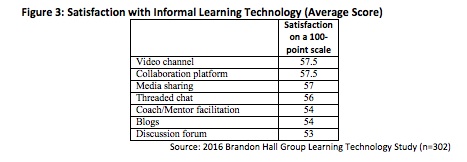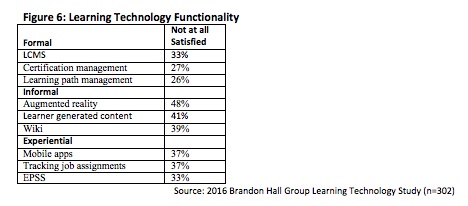
The technology employed to deliver learning and development within organizations has grown increasingly varied and complex. The cloud, social tools, mobile technologies, and other advances have opened up a host of opportunities for new learning experiences—so much so that exploring new technologies has become the top L&D priority. Exploring new and different technologies surpassed even developing a learning strategy as the top focus over the next 12 months, according to Brandon Hall Group’s just-released 2016 Learning Technology Study.

This article will explore the Top 5 findings from the study, conducted in March and early April and garnering more than 300 validated responses from 31 industries and 35 countries, including the U.S., Canada, England, France, Germany, India, Turkey, Australia, and New Zealand.
Top 5 Findings
1. Social and mobile technologies are the biggest priorities.
2. User experience is critical.
3. Integration is becoming more important.
4. Learning technology satisfaction lags.
5. KPIs improve significantly after technology implementation.
1. Social and mobile technologies are the biggest priorities. Companies say new technologies are the top priority, but myriad technology issues are clamoring for attention. Within the chaotic learning environment, the biggest priorities within technology are social and mobile solutions:

Brandon Hall Group has been researching learning technology for years, and mobile and social have been steadily climbing the priority list. Now, they sit firmly on the top, and organizations are hungry for platforms that leverage new technologies to allow for a more “just-in-time, just-for-me” learning experience. While the learning management system (LMS) accounts for about 39 percent of the learning technology budget on average, companies are still spending averages of 4.7 percent and 4.3 percent on social and mobile technologies, respectively. That’s on top of the money they already are spending on their LMS, and more than one-third of companies expect those percentages to grow over the next year.
When it comes to technology-enabled informal learning, more than half of companies consider discussion forums and collaboration platforms as either essential or critical to the business. The problem is that they give all major solutions a failing grade.

When 46 percent of companies consider discussion forums essential and 8 percent consider them critical to the business, it’s a significant problem when only 5 percent say they are very satisfied with the discussion functionality of their current platform.
2. User experience is critical. Approximately 44 percent of companies are actively considering replacing their current LMS solution. This number is up 16 percent from 2015, so what is driving companies to change? An overwhelming 87 percent indicate it is the need for an improved user experience. The second most common reason is the need for an improved administrative experience (74 percent). Ease of use has always been near the top of drivers for change, but never with such authority.

It seems to be common sense that a system should be easy to use, but the stark reality is that many learning software applications are anything but. User experience (UX) is critical in learning, as this software is often the first interaction an employee has with the organization. Also, in our increasingly virtual workforce, it sometimes can be the only connection an employee has with the organization. A bad UX equals poor engagement that can be difficult to turn around.
To put into perspective just how important UX is, 43 percent of companies say an intuitive, user-centric interface is essential when buying new learning technology, and 40 percent say it is critical to their business.
3. Integration is becoming more important. As we see in Figure 4, the need to integrate with other systems is a big factor in why organizations switch learning technology providers. Also, 77 percent of companies say integration capabilities are either essential or critical for their learning technology vendors to have.
The most common systems learning technology integrates with are human resource information systems (HRIS) (37 percent), content management (29 percent), and talent management (28 percent). For many of these systems, organizations are finding it important, if not critical, that their future learning systems integrate.

Looking ahead, 36 percent of companies say it is critical that their next learning technology platform integrates with a talent management system and 36 percent say the same for a content management system. So while integration will be an important aspect of learning technology, only 3 percent of companies say they are satisfied with their current integrations.
As for the learning technology itself, more than two-thirds of companies say the next learning technology they buy will be a suite of integrated technologies from a single vendor. So, despite the APIs and ease of integration that come with the cloud, twice as many companies are interested in suite solutions than are in purchasing best-of-breed solutions and getting them to work together.
4. Learning technology satisfaction lags. The highest average satisfaction rating (on a 4-point scale) for any type of technology—formal, informal, or experiential—is 2.83, while the lowest is 1.90. We’ve seen the impact a poor user interface can have, but there are many other areas in which organizations give learning technology providers failing grades. Let’s take a look at some of the areas that fare the worst:

In the formal arena, one-third of companies are not at all satisfied with the learning content management system (LCMS) aspect of their technology. Content plays a huge role in learning, and an inability to properly manage it can be a challenge. The management of certifications and learning paths also were rated somewhat poorly. However, overall, the technology aspects of formal learning delivery score higher in satisfaction than those for informal and experiential learning, This highlights the difference between technologies and modalities companies have been using for years and those newer technologies they are still grappling with.
5. KPIs improve significantly after technology implementation. Despite its challenges, technology is key to delivering effective learning, and its role will only continue to grow. We asked organizations if there was any change in key performance indicators after implementing their learning technology, and the results are promising:

This does not necessarily represent causation in that the technology is responsible for the improvements, but rather a correlation. Organizations report improvements after implementing the technology. Keep in mind that the vast majority of companies that did not report any improvement indicated that their KPIs remained the same. For example, only 1 percent of companies reported that productivity had decreased.
Companies are recognizing the important role learning technology can play in improving the overall business. Just 3 percent of companies say they have no plans to implement learning technology. And those that are implementing, or have implemented, solutions are putting their money where their mouth is. Nearly half of companies say learning technology typically accounts for 1 percent to 5 percent of the overall HR budget; 25 percent say its 6 percent to 10 percent; and the other 30 percent say it is even more. Some 42 percent of companies expect their allocation to increase next year.
Given the size of the average HR budget, this represents a significant investment in learning technologies moving forward. As companies expand the palette of technologies they want/need, they will become more acutely aware of how each technology helps them achieve their learning goals and, consequently, their business objectives.
David Wentworth is principal Learning analyst for Brandon Hall Group, a human capital management (HCM) research and advisory services firm that provides insights around key performance areas, including Learning and Development, Talent Management, Leadership Development, Talent Acquisition, and HR/Workforce Management.




